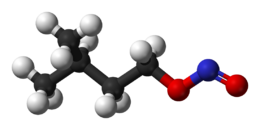User:Mr. Ibrahem/Amyl nitrite
 | |
 | |
| Clinical data | |
|---|---|
| Other names | Isoamyl nitrite, nitramyl, 3-methyl-1-nitrosooxybutane, pentyl alcohol nitrite (ambiguous), poppers, banapple gas |
| Pharmacokinetic data | |
| Onset of action | Within 30 sec[1] |
| Duration of action | About 4 min[1] |
| Identifiers | |
| |
| Chemical and physical data | |
| Formula | C5H11NO2 |
| Molar mass | 117.148 g·mol−1 |
| 3D model (JSmol) | |
| Density | 0.872 g/cm3 |
| Boiling point | 99 °C (210 °F) |
| Solubility in water | Slightly soluble mg/mL (20 °C) |
| |
| |
| (verify) | |
Amyl nitrite is a chemical compound and medication.[2][3] As a medication it has been used for heart related chest pain and cyanide poisoning.[1][2] For chest pain nitroglycerin is now generally used instead.[3] It is also used recreational by inhalation with claims that it makes a person high and improves sexual function.[1][3] Effects begin within 30 seconds and last about 4 minutes.[1]
Common side effects may include headache, flushing of the skin, and lightheadedness.[1] Other side effects may include fainting, lose of bladder control, low blood pressure, and nausea.[1] Large doses may result in methemoglobinemia.[1] Tolerance to its effects may occur with withdrawal after it is stopped.[2] It is a yellow liquid with a smell that has been described as fruity.[4][2] Medically it works by dilating blood vessels.[2]
Amyl nitrite was first documented in 1844 and came into medical use in 1867.[5] It was available as a generic medication; however, is no longer approved for medical use in the United States.[6][1] It came into common recreational use in the 1960s particularly by the gay community in the United States.[2][4] Common street names include "poppers" and "pearls".[2] Butyl nitrite and isobutyl nitrite are sometimes sold claiming to be amyl nitrite for recreational use.[2]
References[edit]
- ^ a b c d e f g h i "Amyl Nitrite Inhalant - FDA prescribing information, side effects and uses". Drugs.com. Archived from the original on 3 May 2021. Retrieved 13 October 2020.
- ^ a b c d e f g h Fisher, Gary L.; Roget, Nancy A. (2012). Encyclopedia of Substance Abuse Prevention, Treatment, and Recovery. SAGE Publications. p. 71. ISBN 978-1-4522-6601-5. Archived from the original on 2021-05-05. Retrieved 2020-11-11.
- ^ a b c Stimmel, Barry (2002). Alcoholism, Drug Addiction, and the Road to Recovery: Life on the Edge. Psychology Press. p. 274. ISBN 978-0-7890-0553-3. Archived from the original on 2021-05-05. Retrieved 2020-11-11.
- ^ a b Rietschel, Robert L.; Fowler, Joseph F.; Fisher, Alexander A. (2008). Fisher's Contact Dermatitis. PMPH-USA. p. 49. ISBN 978-1-55009-378-0. Archived from the original on 2021-05-03. Retrieved 2020-11-11.
- ^ Fischer, Jnos; Ganellin, C. Robin (2006). Analogue-based Drug Discovery. John Wiley & Sons. p. XXX. ISBN 9783527607495. Archived from the original on 2021-05-03. Retrieved 2020-09-19.
- ^ Fraunfelder, Frederick T.; Fraunfelder, Frederick W.; Chambers, Wiley A. (2008). Drug-Induced Ocular Side Effects: Clinical Ocular Toxicology E-Book. Elsevier Health Sciences. p. 164. ISBN 978-0-323-31985-0. Archived from the original on 2021-05-03. Retrieved 2020-10-13.
